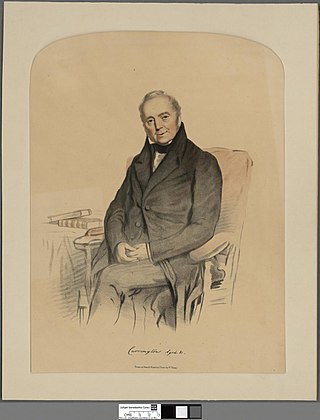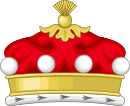
Marquess of Linlithgow, in the County of Linlithgow or West Lothian, is a title in the Peerage of the United Kingdom. It was created on 23 October 1902 for John Hope, 7th Earl of Hopetoun. The current holder of the title is Adrian Hope.

Earl of Haddington is a title in the Peerage of Scotland. It was created in 1627 for the noted Scottish lawyer and judge Thomas Hamilton, 1st Earl of Melrose. He was Lord President of the Court of Session from 1616 to 1625. Hamilton had already been created Lord Binning in 1613 and Lord Binning and Byres, in the County of Haddington, and Earl of Melrose, in the County of Roxburgh, in 1619. These titles were also in the Peerage of Scotland. The title of the earldom derived from the fact that he was in possession of much of the lands of the former Melrose Abbey. However, Hamilton was unhappy with this title and wished to replace it with "Haddington". In 1627 he relinquished the earldom of Melrose and was instead created Earl of Haddington, with the precedence of 1619 and with limitation to his heirs male bearing the surname of Hamilton. This derived from the fact that he considered it a greater honour to take his title from a county rather than from an abbey. Hamilton was a member of the prominent Scottish family of that name and descended from John de Hamilton, younger son of Walter de Hamilton, who was granted the feudal barony of Cadzow and who is also the ancestor of the Dukes of Hamilton and Dukes of Abercorn.

Earl of Dundonald is a title in the Peerage of Scotland. It was created in 1669 for the Scottish soldier and politician William Cochrane, 1st Lord Cochrane of Dundonald, along with the subsidiary title of Lord Cochrane of Paisley and Ochiltree, with remainder to his heirs male, failing which to his heirs female without division who should bear or assume the name of Cochrane, and in failure thereof to his heirs general. In 1647, he had already been created Lord Cochrane of Dundonald in the Peerage of Scotland, with remainder to the heirs male of his body.

Earl Granville is a title that has been created twice, once in the Peerage of Great Britain and once in the Peerage of the United Kingdom. It is now held by members of the Leveson-Gower family.

Earl Beatty is a title in the Peerage of the United Kingdom. It was created in 1919 for the prominent naval commander Admiral of the Fleet Sir David Beatty. He was created Baron Beatty, of the North Sea and of Brooksby in the County of Leicester, and Viscount Borodale, of Wexford in the County of Wexford, at the same time, also in the Peerage of the United Kingdom. The latter title is used as a courtesy title for the Earl's eldest son and heir apparent. Lord Beatty was succeeded by his eldest son, the second Earl. He represented Peckham in the House of Commons as a Conservative from 1931 to 1936 and briefly served as Under-Secretary of State for Air in Winston Churchill's 1945 caretaker government. As of 2014 the titles are held by his eldest son, the third Earl, who succeeded in 1972.

Earl Cawdor, of Castlemartin in the County of Pembroke, is a title in the Peerage of the United Kingdom. It was created in 1827 for John Campbell, 2nd Baron Cawdor.

Earl of Effingham, in the County of Surrey, is a title in the Peerage of the United Kingdom, created in 1837 for Kenneth Howard, 11th Baron Howard of Effingham, named after the village of Effingham, Surrey, where heads of the family owned the manor.

Earl Cairns is a title in the Peerage of the United Kingdom. It was created in 1878 for the prominent lawyer and Conservative politician Hugh Cairns, 1st Baron Cairns. He was Lord High Chancellor of Great Britain in 1868 and from 1874 to 1880. Cairns had already been created Baron Cairns, of Garmoyle in the County of Antrim, in 1867, and was made Viscount Garmoyle, in the County of Antrim, at the same time he was given the earldom. These titles are also in the Peerage of the United Kingdom.
Viscount Hampden is a title that has been created twice, once in the Peerage of Great Britain and once in the Peerage of the United Kingdom. The first creation came in the Peerage of Great Britain when the diplomat and politician Robert Hampden, 4th Baron Trevor, was created Viscount Hampden, of Great and Little Hampden in the County of Bedford on 14 June 1776. The title of Baron Trevor, of Bromham, had been created in the Peerage of Great Britain in 1712 for his father, the lawyer Sir Thomas Trevor. Both titles became extinct in 1824 on the death of the first Viscount's second son, the third Viscount.

Baron Carrington is a title that has been created three times, once in the Peerage of England, once in the Peerage of Ireland and once in the Peerage of Great Britain.

Baron Feversham is a title that has been created twice, once in the Peerage of Great Britain and once in the Peerage of the United Kingdom. The first creation, in the Peerage of Great Britain, came in 1747 when Anthony Duncombe, who had earlier represented Salisbury and Downton in the House of Commons, was made Lord Feversham, Baron of Downton, in the County of Wilts. He had previously inherited half of the enormous fortune of his uncle Sir Charles Duncombe. However, Lord Feversham had no sons and the barony became extinct on his death in 1763. The peerage was revived in the Peerage of the United Kingdom in 1826 in favour of his kinsman Charles Duncombe, who was created Baron Feversham, of Duncombe Park in the County of York. He was a former Member of Parliament for Shaftesbury, Aldborough, Heytesbury and Newport. Duncombe was the grandson of Thomas Duncombe, son of John Brown by his wife Ursula Duncombe, aunt of the first Baron of the 1747 creation. Ursula had inherited the other half of her brother Sir Charles Duncombe's fortune. Lord Feversham son, the second Baron, sat as a Conservative Member of Parliament for Yorkshire and the North Riding of Yorkshire.
Baron Cochrane of Cults, of Crawford Priory in the County of Fife, is a title in the Peerage of the United Kingdom. It was created in 1919 for the Liberal Unionist politician and former Under-Secretary of State for the Home Department, the Hon. Thomas Cochrane. He was the second and youngest son of Thomas Barnes Cochrane, 11th Earl of Dundonald. As of 2017 the title is held by the first Baron's great-grandson, the fifth Baron, who succeeded his father in that year.

Alexander Dundas Ross Cochrane-Wishart-Baillie, 1st Baron Lamington, better known as Alexander Baillie-Cochrane, was a British Conservative politician perhaps best known for his association with Young England in the early 1840s.

Thomas Horatio Arthur Ernest Cochrane, 1st Baron Cochrane of Cults, was a Scottish soldier and Liberal Unionist politician. He was Under-Secretary of State for the Home Department under Arthur Balfour between 1902 and 1905.

James Alexander Stewart-Mackenzie was a Scottish politician and British colonial administrator.
Edward O'Neill, 2nd Baron O'Neill, known as Edward Chichester until 1855, was an Irish peer and Conservative politician.

James Hope-Johnstone, 3rd Earl of Hopetoun FRSE was a Scottish peer, politician and military officer.

Charles Wallace Alexander Napier Cochrane-Baillie, 2nd Baron Lamington,, was a British politician and colonial administrator who served as Governor of Queensland from 1896 to 1901, and Governor of Bombay from 1903 to 1907.
Thomas Barnes Cochrane, 11th Earl of Dundonald was a Scottish nobleman. He was son of the radical politician and sailor Thomas Cochrane, 10th Earl of Dundonald. As a child he accompanied his father to Chile as a stowaway on the Chilean frigate O'Higgins (1816). In February 1819 the O'Higgins attempted to raid the city of Callao, but was repelled by the coastal fortresses. Thomas Cochrane 11th was almost hit by a cannonball, which instead killed a sailor next to him.
Dame Anne Annette Minna Cochrane was a British courtier.














